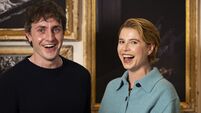Moths shown in a new light
More often I just sit and enjoy the sounds and smells of the countryside.
I live a long way from anything resembling a main road and by midnight most of the human generated sounds have stopped. An occasional aircraft passes over head and some nights when Bord na Mona has a quota to meet the great milling machines growl away on the bog until dawn.
But usually there comes a time when all you can hear are the sounds of nature and the occasional noises made by cattle, sheep and dogs. A fox’s bark will wake a roosting cock pheasant and provoke a loud alarm call.
Bats squeak, sometimes I hear an owl and often there are sounds I can’t identify.
On a good night the flower scents on the breeze are magnificent. Early in the summer cow parsley is dominant, followed by hawthorn, elder, honeysuckle and dog rose. A good Irish hedgerow is like a perfume factory on a summer’s night.
Then, of course, if there is a light switched on the moths arrive. They spiral in from the darkness and often crash into the bulb and fall to the ground, dazed by the impact. This is obliging of them because it gives me time to get a good look and compare their markings with the colour illustrations in my moth books before they fly off again. The reason moths do this is probably that artificial light confuses their navigation systems.
The proper way to study moths is by using a moth trap. You can buy these over the internet but they’re not difficult things to make. You need a light source, the traps you buy use a special bulb that’s particularly efficient but this isn’t absolutely necessary. This is connected to a sort of funnel arrangement that allows the dazed insect to slip comfortably into a dark box that is normally filled with cardboard egg cartons.
The moth makes itself at home in a compartment of the egg carton and, when you open the trap in the morning to identify and release it, it’s usually fast asleep.
THE DONEGAL naturalist Ralph Sheppard has been trapping and recording moths in his part of the country for many years now.
At the last count he had identified 178 different species just on his own land. There are around 500 species of the larger moths in Ireland, of which about 350 are likely to be found in a given area.
When you consider that we have less than 30 butterfly species, including migrants and extreme rarities, the moth list is impressive.
Some of the English names for these moths are as amazing as the insects themselves. Why on earth did some naturalist in the past decide to call an insect The Suspected or The Anomalous? Then there’s Argent and Sable, Mother Shipton, Powdered Quaker’ and Chamomile Shark.
Moths are found in almost every type of habitat, including urban ones. But the greatest variety of species is found in native woodland, the older the better.
Old hedgerows with a mixture of plant species are also good for moths. I have some carr woodland near my house with birch, alder and willow species in it and this has its own moth fauna, including the spectacular Poplar Hawk Moth.
If you want to find out a bit more about moths and Ralph Sheppard’s work log on to the Donegal Moths website at www.skylark/donegalmoths.
This has a good selection of photographs of different species. There is also a group called Moths Ireland which runs an internet discussion group.
* dick.warner@examiner.ie













